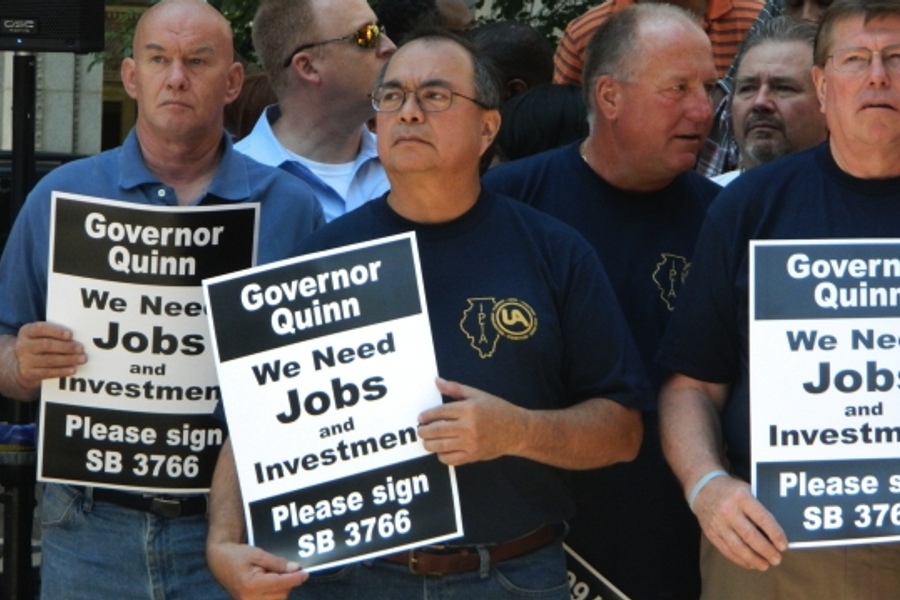
CHICAGO — “Governor Quinn, these construction boots we’re wearing are made for working. Governor Quinn, we put these boots to work to get you elected. Governor Quinn, put these construction boots to work and sign this bill.”
So said Chicago Regional Council of Carpenters business representative Daniel McMahon, standing outside the State of Illinois building on July 9, wearing a hard hat and surrounded by burly union members brandishing signs reading “We Need Jobs and Investment.”
McMahon and local elected officials were calling on the Illinois governor to sign SB 3766, a bill that will allow the company Leucadia National Corporation to recover 100 percent of construction costs for a coal gasification plant it wants to build on the city’s southeast side. (As things currently stand, it can recover 84 percent of construction costs by charging customers with Nicor Gas and Ameren for the synthetic natural gas the plant will produce.) The company says the plant will not be built without the bill’s passage. Critics argue that the plant is a bad deal for ratepayers, who will be committed to purchase the gas for 30 years at rates which could end up significantly above market rates.
The plant is projected to create 1,000 temporary construction jobs, 200 permanent jobs and 600 to 700 indirect jobs in Chicago, plus about 200 coal mining-related jobs downstate. Under legislation signed last summer, the plant would use at least 50 percent Illinois coal and up to 50 percent petroleum coke from oil refineries, turning it into gas that can be used instead of natural gas for residential and industrial customers.
“This bill not only benefits the city of Chicago, it benefits downstate,” said State Sen. Donne E. Trotter, referring to the state’s mining industry. “We’re using our natural resources.”
McMahon and Millwrights business rep John Dunne said the jobs created in Chicago would almost surely be union and would be an economic salvation for the struggling southeast side. He said the unions would make sure local residents were trained in the kind of skills needed for the jobs.
Hoyt Hudson, a representative for the Chicago Clean Energy project (as the plant is known), said that if the bill is passed, jobs will be created next year to carry out the $25-30 million brownfield remediation the company has promised to do on the site, a former coke plant. Actual construction of the gasification plant still depends on many uncertain factors including permitting, financing and the construction of a pipeline to carry carbon dioxide to the Gulf Coast.
McMahon accused opponents of the plant of being “special interest groups” from outside the community. But on July 10, scores of local residents turned out to urge Quinn to veto the bill, presenting 11,250 petitions to that effect. They say the gasification plant offers the wrong kind of jobs for an area that is already heavily polluted from decades of heavy industry, much of it now closed up. Even though the plant’s emissions of toxic pollutants would be low, critics note that residents and workers would be exposed to harmful diesel emissions from trucks and machinery and dust from the transportation and storage of coal and petroleum coke.
Environmentalists also oppose the creation of coal mining jobs, pointing to reports like the recent investigation by NPR and the Center for Public Integrity blaming unethical coal companies and lax government oversight for continued high rates of black lung disease. (The United Mineworkers of America, by contrast, is pushing for development of more so-called “clean coal” projects like the gasification plant.)
“We want jobs, but we want jobs that won’t kill us,” said Robert Garcia, 35, a student who lives on the southeast side and is looking for work. “If more polluting industries come in, it will be harder to attract the kind of clean jobs we want.”
“This is the wrong kind of investment,” added Rev. Zaki L. Zaki, superintendent of the Northwest District of the United Methodist Church. “We need to be intentional about creating a green energy hub. The south side of Chicago presents itself as the perfect place. There are a whole range of green technologies we could see here, research centers, actual energy generation, solar and wind production. If anyone can dream big, it’s we as Chicagoans.”
Kari Lydersen is a Chicago-based journalist, author and assistant professor at Northwestern University, where she leads the investigative specialization at the Medill School of Journalism, Media, Integrated Marketing Communications. Her books include Mayor 1%: Rahm Emanuel and the Rise of Chicago’s 99%.








